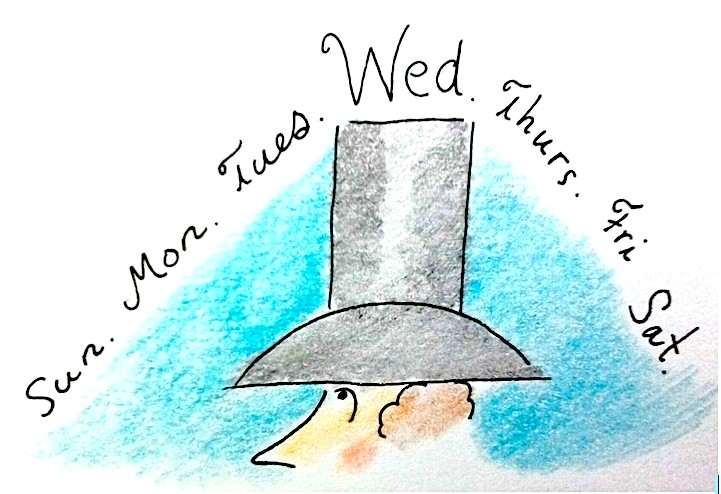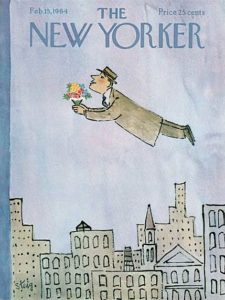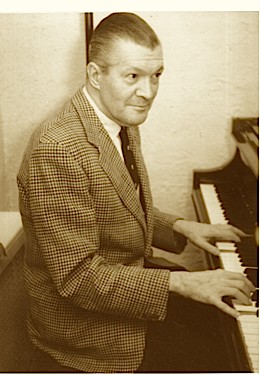Map Covers
There’ve been a number of New Yorker covers over its 97 years that use maps as a focus, or theme. One of the most popular is this one (if numbers of shower curtains sold is an indication of popularity). But I’m thinking this morning of these other map covers, all gems. Top left, clockwise: William Steig*, Arthur Getz, James Stevenson.
*The Steig cover issue is notable for its “Notes and Comment.” E.B. White, who had been writing “Notes and Comment” since 1927, was taking a leave of absence. I’ll quote White’s biographer Scott Elledge here:
“White’s farewell to readers of ‘Talk of the Town’ appeared in The New Yorker for August 7, 1937. It took the form of a whimsical account of Eustace Tilley’s departure from New York, and its significance was clear only to those who had heard beforehand of White’s decision to take a leave of absence.”
Appearing at the bottom of the page, this Otto Soglow drawing showing Peter Arno’s Whoops Sisters bidding Eustace adieu, and a Thurber dog shedding a tear. :
The A-Zs of the artists mentioned above:

Otto Soglow Born, Yorkville, NY, December 23, 1900. Died in NYC, April 1975. New Yorker work: 1925 -1974.Key collections: Pretty Pictures ( Farrar & Rinehart, 1931) and for fans of Soglow’s Little King; The Little King (Farrar & Rinehart, 1933) and The Little King ( John Martin’s House, Inc., 1945). The latter Little King is an illustrated storybook. Cartoon Monarch / Otto Soglow & The Little King (IDW, 2012) is an excellent compendium.
William Steig (photo above) Born in Brooklyn, NY, Nov. 14, 1907, died in Boston, Mass., Oct. 3, 2003. In a New Yorker career that lasted well over half a century and a publishing history that contains more than a cart load of books, both children’s and otherwise, it’s impossible to sum up Steig’s influence here on Ink Spill. He was among the giants of the New Yorker cartoon world, along with James Thurber, Saul Steinberg, Charles Addams, Helen Hokinson and Peter Arno. Lee Lorenz’s World of William Steig (Artisan, 1998) is an excellent way to begin exploring Steig’s life and work. NYer work: 1930 -2003.

James Stevenson Born, NYC, 1929. Died, February 17, 2017, Cos Cob, Connecticut. New Yorker work: March 10, 1956 -. Stevenson interned as an office boy at The New Yorker in the mid 1940s when he began supplying ideas for other New Yorker artists. Nine years later he was hired a full-time ideaman, given an office at the magazine and instructed not to tell anyone what he did. He eventually began publishing his own cartoons and covers as well as a ground-breaking Talk of the Town pieces (ground breaking in that the pieces were illustrated). His contributions to the magazine number over 2000. Key collections: Sorry Lady — This Beach is Private! ( MacMillan, 1963), Let’s Boogie ( Dodd, Mead, 1978). Stevenson was a children’s book author, with roughly one hundred titles to his credit. He was a frequent contributor to the Op-Ed page of The New York Times, under the heading Lost and Found New York. Stevenson’s The Life, Loves and Laughs of Frank Modell, published in 2013, is essential reading. Sally Williams’ 2019 documentaryfilm, Stevenson Lost & Found is essential viewing.
 Arthur Getz Born, Passaic, New Jersey, 1913; died, 1996. NYer work: 1938 -1988. Primarily a cover artist, he had one cartoon published: March 15, 1958. (You might say his career was a mirror image of George Price’s, who was one of the most prolific cartoonists, with over 1200 published, and one cover). According to the official Getz website, he was the most prolific of all New Yorker cover artists, having 213 appear during the fifty years he contributed to the magazine. The official Getz website, containing his biography: getzart.com/
Arthur Getz Born, Passaic, New Jersey, 1913; died, 1996. NYer work: 1938 -1988. Primarily a cover artist, he had one cartoon published: March 15, 1958. (You might say his career was a mirror image of George Price’s, who was one of the most prolific cartoonists, with over 1200 published, and one cover). According to the official Getz website, he was the most prolific of all New Yorker cover artists, having 213 appear during the fifty years he contributed to the magazine. The official Getz website, containing his biography: getzart.com/
Peter Arno (Pictured above. Source: Look, 1938) Born Curtis Arnoux Peters, Jr., January 8, 1904, New York City. Died February 22, 1968, Port Chester, NY. New Yorker work: 1925 -1968. Key collection: Ladies & Gentlemen (Simon & Schuster, 1951) The Foreword is by Arno. For far more on Arno please check out my biography of him, Peter Arno: The Mad Mad World of The New Yorker’s Greatest Cartoonist (Regan Arts, 2016).

James Thurber Born, Columbus, Ohio, December 8, 1894. Died 1961, New York City. New Yorker work: 1927 -1961, with several pieces run posthumously. According to the New Yorker’s legendary editor, William Shawn, “In the early days, a small company of writers, artists, and editors — E.B. White, James Thurber, Peter Arno, and Katharine White among them — did more to make the magazine what it is than can be measured.”
Key cartoon collection: The Seal in the Bedroom and Other Predicaments (Harper & Bros., 1932). Key anthology (writings & drawings): The Thurber Carnival (Harper & Row, 1945). There have been a number of Thurber biographies. Burton Bernstein’s Thurber (Dodd, Mead, 1975) and Harrison Kinney’s James Thurber: His Life and Times (Henry Holt & Co., 1995) are essential. Website










